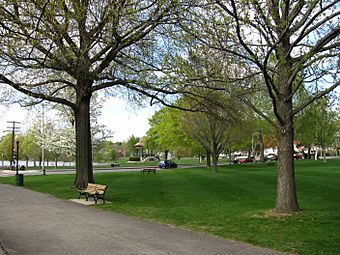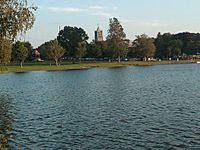Common District (Wakefield, Massachusetts) facts for kids
Quick facts for kids |
|
|
Common District
|
|

Wakefield Common
|
|
| Location | Wakefield, Massachusetts |
|---|---|
| Area | 25 acres (10 ha) |
| Architect | Multiple |
| Architectural style | Late 19th And 20th Century Revivals, Late Victorian |
| MPS | Wakefield MRA |
| NRHP reference No. | 89000754 |
| Added to NRHP | March 2, 1990 |
The Common District is a very important area in Wakefield, Massachusetts. It's like the main town center! This district is built around the historic town common, which is a large open space. It sits just south of Lake Quannapowitt. The common was first created in 1644. Back then, it was the heart of a place called Old Reading.
The area became its own town, South Reading, in 1818. It was later renamed Wakefield in 1868. This district covers about 25 acres. It includes many important buildings along Common Street and Main Street. These buildings include the town hall, public library, YMCA, post office, and several churches. The Common District was added to the National Register of Historic Places in 1990. This means it's a special place worth protecting.
Exploring the Common District's History
The town of Wakefield is located north of Boston, Massachusetts. It was originally part of Reading. Reading was founded in 1644 on the southern shore of Lake Quannapowitt. Wakefield became a separate town in 1818. It was first called South Reading, then renamed Wakefield in 1868.
The Common: A Community Hub Since 1647
The common area has always been the center of community life. It served as a place for both town meetings and religious gatherings. The common itself was officially set aside in 1647. Its exact borders were marked more clearly in 1741. Since then, important buildings and homes have been built around it. The original town burial ground is located behind the First Congregational Church. The current church building was built around 1892.
Historic Buildings Around the Common
Many old and beautiful buildings stand around the common. The oldest ones date back to the early 1800s. These include some Federal-style houses. The First Universalist Church, built in 1839, is also from this period. Besides the Universalist and Congregational Churches, there are two other churches. These were built later in the 1800s.
Most of Wakefield's main public buildings were built in the early 1900s. These include the Lucius Beebe Memorial Library (1923). The main post office was built in 1936. The YMCA building was completed in 1938. The Town Hall building has an interesting history. It was first built in the 1800s as a high school. It had an Italianate style. In 1938, it was changed to house town offices. At that time, it was also restyled to look different.





